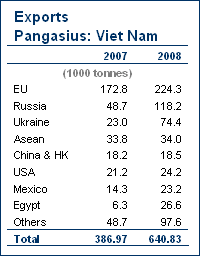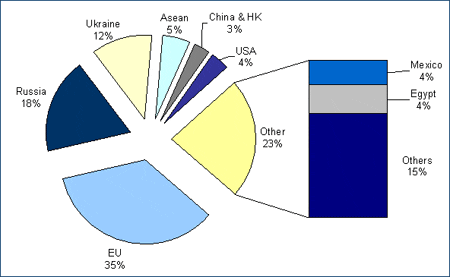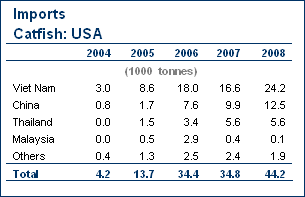Vietnamese pangasius still in a bonanza phase...
Compared with 2007, Pangasius exports increased by 48 per cent in value and 66 per cent in quantity. The growth slowed down somewhat in the last quarter, as a reaction to the worldwide economic downturn. In fact total 2008 exports stayed somewhat below earlier forecasts.

Vietnamese growers are suffering from reduced prices, pangasius is fetching around USD 0.92/ kilo in the Mekong Delta region, which makes production uneconomic. As a reaction to low prices, farmers are refraining from selling fish, and others are not restocking. More than 90 per cent of pangasius breeders reported losses in 2008, and between 40 per cent and 50 per cent of growing ponds in the Mekong area are lying empty, which has led to forecasts that production will be half what it was last year. This is very much in contrast with the official forecast of further increase in production to almost 1.5 million tonnes in 2009.

Vietnamese growers are suffering from reduced prices, pangasius is fetching around USD 0.92/ kilo in the Mekong Delta region, which makes production uneconomic. As a reaction to low prices, farmers are refraining from selling fish, and others are not restocking. More than 90 per cent of pangasius breeders reported losses in 2008, and between 40 per cent and 50 per cent of growing ponds in the Mekong area are lying empty, which has led to forecasts that production will be half what it was last year. This is very much in contrast with the official forecast of further increase in production to almost 1.5 million tonnes in 2009.
Russia is now by far the main market for pangasius from Viet Nam, with 118 000 tonnes. This was more than double the 2007 amount. This country alone accounts for 18 per cent of the Vietnamese exports of pangasius. Imports into Russia expanded by 142 per cent in volume and by 200 per cent in value. The unit value of Russian pangasius is extremely low, at USD 1.40/kg, while the EU pays about USD 0.80/kg more for the pangasius it is importing from Viet Nam. The low unit value in Russia can be explained by imports of lower grade products into Russia, as fillets are mainly with belly, fat and red meat. The depreciation of the Russian rouble against the USD and the EUR also contributed to lower unit value.
Ukraine is the second major importer of pangasius from Viet Nam, with 74 400 tonnes in 2008, more than triple the 2007 amount. Ukraine is paying somewhat more for its pangasius, at USD 1.95/kg. Even stronger growth was recorded in Egypt, where pangasius imports grew by over 300 per cent in just one year. VASEP, the Vietnamese seafood promotion agency, is concentrating on markets in the Middle East at the moment, successfully as can be noted by this performance.

The EU is the main market for pangasius from Viet Nam, with about one third of imports in quantity and 40 per cent in value terms. Within the EU, Spain is the biggest market, growing by 28 per cent. Demand for pangasius from the European market usually increases every year starting at the end of September; however, 2008 was a bit a difficult year.
Pangasius consumption has grown rapidly in Spain in the past few years. The presence of pangasius, commonly called Panga, is overwhelming; there is practically no fish shop in the country without panga fillets. The product is generally sold in fresh form, but it is not always indicated that the product is defrosted. In addition, in the indications on the origin, obligatory in EU traceability law, the product is very often identified as wild caught product, sometime even coming from the Atlantic. Prices at retail level are extremely low at EUR 5.70/kg, the lowest priced fillet available in the market. Import prices into Spain have declined over the years, from some EUR 3.50/kg just two years ago to below EUR 2.00/kg at present. Nile perch fillets are sold side by side with panga in the main retail markets, but this species is getting a EUR 2.00-3.00/kg premium over panga.
Spanish domestic fishermen are suffering from this tough competition, and have complained to their government. Some lobbyists said that there were cases of food poisoning related to pangasius imported from Viet Nam, The Spanish agency for Food Security and Nutrition tested batches of catfish imported into Spain from Viet Nam in July 2008, these tested negative for any toxic substances banned by the EC. In January 2009, Spain’s Ministry of Health and Consumer Affairs confirmed Vietnamese catfish met food safety regulations set by the EU and posed no danger to consumer health.
Imports of pangasius are up 62 per cent in Germany in 2008 compared to 2007. Added value id being given to the species by German companies, including an organic range as well as the introduction of some high-end smoked products. In October 2008, a consumer journal article found several problems concerning quality and residues, with pangasius products in German supermarkets. Imports of pangasius slowed down in the closing months of the year, probably to the overall economic crisis and perhaps also to the quality concerns. However, it is likely that consumption of pangasius will increase again in the future, as the price conscious German market will turn to cheaper fish products as the recession continues to bite.
Viet Nam tried to open up other EU market, especially in the Eastern part of the union. However, a sharp drop in unit values was experienced in most markets. In Romania the unit value fell from EUR 2.12/kg to EUR 1.24/kg, in Slovenia from EUR 2.22/kg to 1.57/kg. Again the currency depreciation in these countries was the main reason for this decline.
The US catfish market is growing quite impressively. In 2008, some 44 200 tonnes were imported, 27 per cent more than in the same period of last year. Viet Nam accounts more than half of this quantity, while China reported a strong increase in its catfish supplies to the US market, after tough controls enforced last year. At present China accounts for about 27 per cent of total US catfish imports.

Record forecast for 2009 unlikely to be met
Viet Nam is aiming to produce some 1.5 million tonnes of pangasius in 2009. However, producers are feeling the difficult economic environment and have asked the government to take measures to ensure credit supply for catfish producers and processors. In addition, the low prices prevailing in the second half of 2008 prompted farmers not to restock their ponds. Therefore the production goal looks over-optimistic.
Viet Nam will continue to look for alternative markets for its products, probably moving more high quality pangasius into the EU and into the US market, while Eastern European countries will receive products with more glazing, but at competitive price levels.
Demand for pangasius should be good in these times of economic crisis, where consumers are looking for inexpensive products. Pangasius is likely to be the ideal products in the US and the Western European market for a more careful customer. In the Eastern part of the continent, the market is expected to be less interesting, as the prevailing price levels are not attractive for Vietnamese producers.
May 2009


